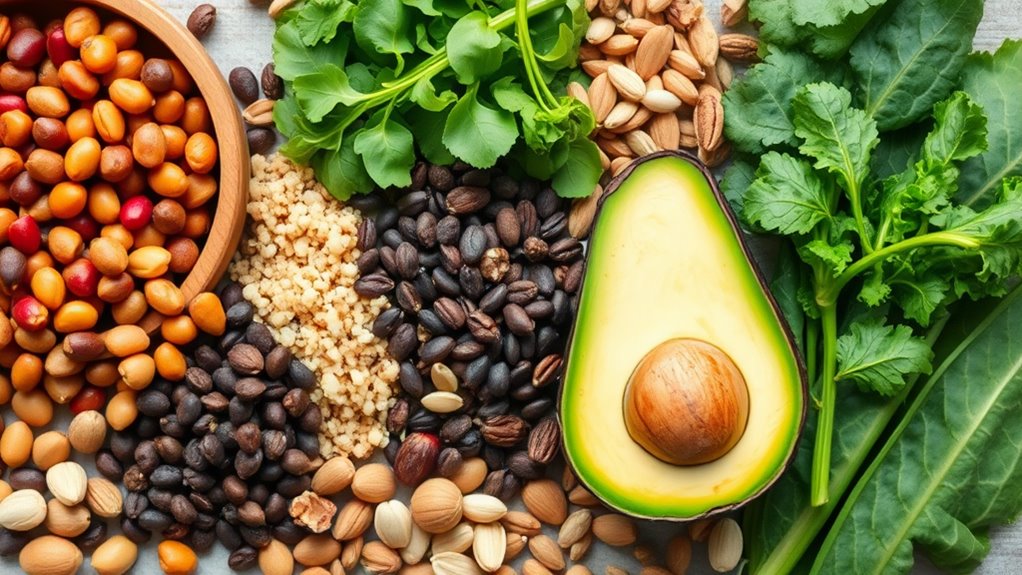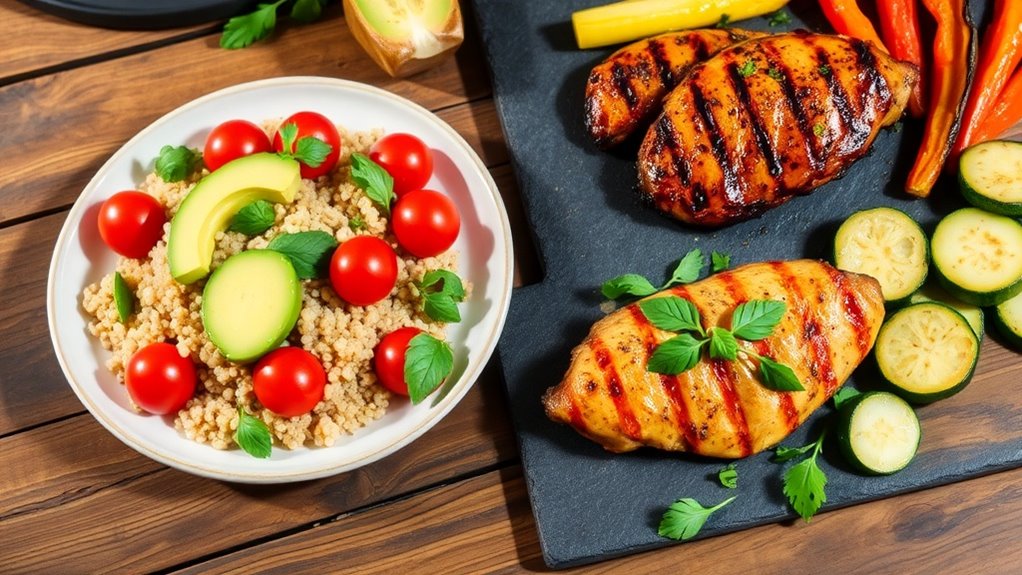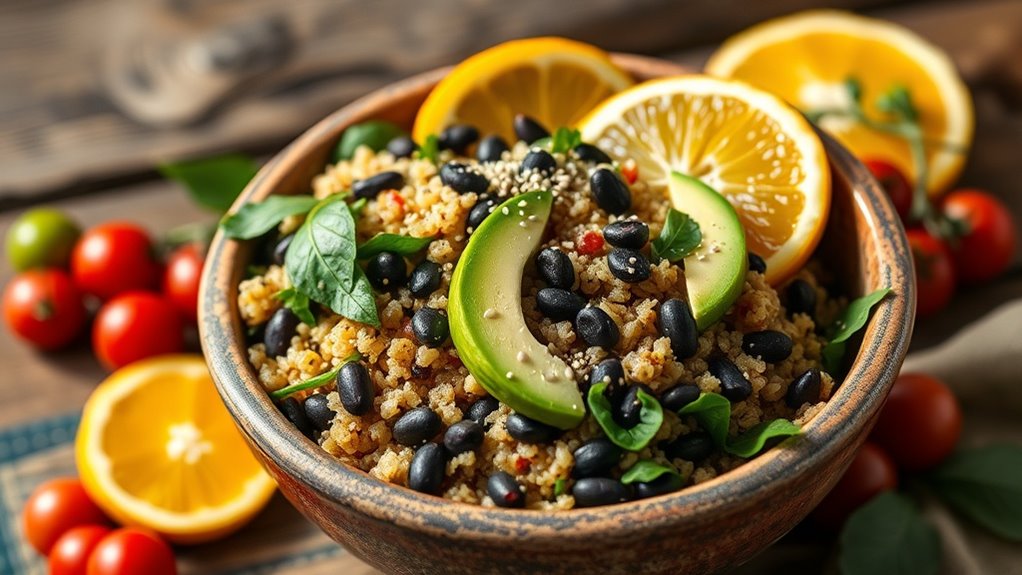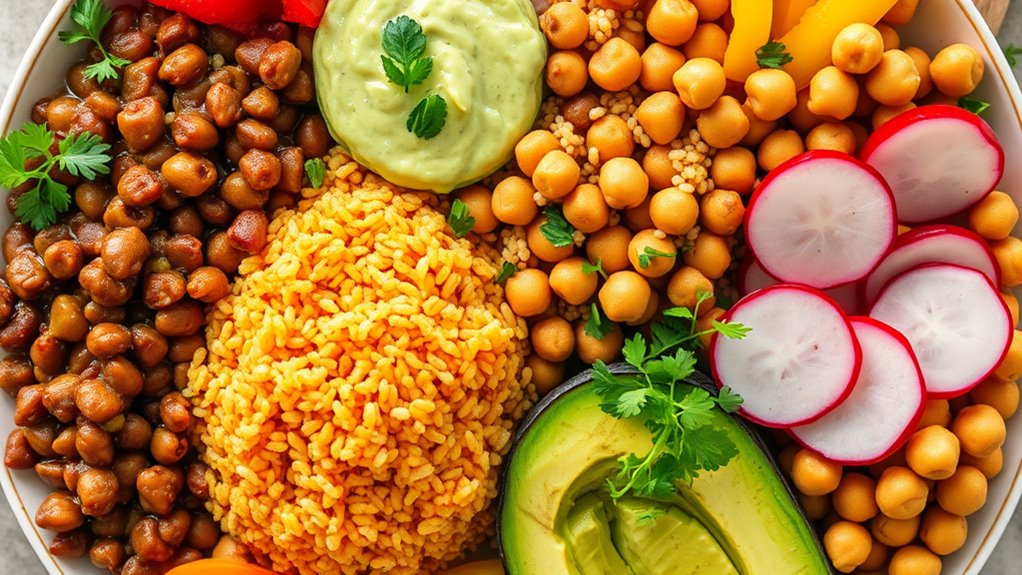Discover the Best Plant-Based Protein Options Around!
If you’re looking for the best plant-based protein options, legumes like beans, lentils, and peas are top picks. Nuts and seeds, such as almonds and chia, pack a protein punch too. Don’t forget about grains like quinoa and farro, which add unique flavors while boosting nutrition. Tofu and tempeh are versatile and absorb flavors well, and protein-rich vegetables like spinach and broccoli enhance your meals. There’s so much more to explore, so keep going for great insights!
Key Takeaways
- Legumes like beans, lentils, and peas are excellent sources of plant-based protein, packed with fiber and essential nutrients.
- Nuts and seeds, including almonds and chia seeds, provide healthy fats and protein to support recovery and overall wellness.
- Quinoa is a complete protein, containing all nine essential amino acids, making it a top choice among plant-based grains.
- Tofu and tempeh are versatile sources of protein that can absorb flavors, perfect for diverse culinary applications.
- Protein-rich vegetables like spinach, peas, and lentils enhance meals while delivering vital vitamins and minerals for health.
The Power of Legumes: Beans, Lentils, and Peas
Legumes, like beans, lentils, and peas, pack a powerful punch when it comes to plant-based protein. In fact, they’re among the best plant proteins available.
You’ll find that these nutrient-dense foods aren’t just protein-rich but also high in fiber, vitamins, and minerals. Incorporating legumes into your meals is a mastery move for any health-conscious individual.
You can whip up hearty soups, savory stews, or simple salads, all while maximizing your protein intake. Experiment with various varieties like chickpeas or black beans to discover unique flavors and textures. Additionally, legumes serve as an excellent source of plant-based nutrients that contribute to overall health and wellness.
Nutty Delights: Exploring Nut and Seed Proteins
In addition to legumes, nuts and seeds offer a fantastic source of plant-based protein. Almonds, walnuts, chia seeds, and hemp seeds aren’t only rich in protein but also packed with essential fats, vitamins, and minerals.
By incorporating these nutrient-dense foods into your diet, you can enhance muscle recovery and support overall health. Research has shown that plant-based protein sources can improve overall well-being by providing a well-rounded nutrient profile.
Almonds provide about 6 grams of protein per ounce, while chia seeds contain 5 grams and a wealth of omega-3 fatty acids. Flaxseeds and sunflower seeds also contribute favorable amounts of protein, along with fibers that promote digestive health.
Don’t overlook nut butters—these versatile spreads can elevate smoothies, oatmeal, or snacks while delivering a satisfying protein punch.
Explore these options and elevate your plant-based repertoire!
Grains With Gains: Quinoa, Farro, and Beyond
When it comes to plant-based proteins, grains like quinoa and farro pack a powerful punch. Quinoa’s complete protein profile includes all nine essential amino acids, making it a must-have in your pantry. It’s gluten-free, versatile, and can easily elevate salads, stir-fries, and bowls.
Farro, on the other hand, boasts a nutty flavor and a chewy texture, enriching your dishes while offering a solid protein boost. Don’t overlook other grains like buckwheat or barley, each contributing unique flavors and nutrients. Additionally, unique protein sources such as spelt and teff can further diversify your meals while enhancing their nutritional value.
Incorporating these grains expands your culinary repertoire while providing significant health benefits. Experimenting with different grains can transform ordinary meals into nutritional powerhouses, ensuring you meet your protein needs while savoring every bite.
Tofu and Tempeh: Versatile Plant Proteins
Though often overlooked, tofu and tempeh are two of the most versatile plant proteins available. Both can effortlessly absorb flavors, making them perfect for a variety of dishes.
Tofu, with its soft or firm texture, can be grilled, sautéed, or blended into smoothies, while tempeh boasts a nutty flavor that enhances stir-fries or sandwiches. Packed with protein, these options can fuel your workouts and promote muscle recovery. Many people are also discovering unconventional protein sources, which can further diversify their diets.
Experiment with marinades and spices to elevate their taste, or try crumbling them into recipes for added texture. Don’t shy away from exploring different types, such as smoked or seasoned varieties. By incorporating tofu and tempeh into your meals, you’ll be revealing endless culinary possibilities while achieving your nutritional goals.
Protein-Rich Vegetables: Greens and Beyond
Many people overlook the protein potential in vegetables, but certain greens and legumes can pack a surprising nutritional punch.
For instance, spinach offers around 5 grams of protein per cooked cup, while kale brings in a solid 4 grams. Don’t forget about the mighty pea—just one cup packs over 8 grams!
Adding legumes like lentils and chickpeas elevates your meals, with lentils boasting about 18 grams per cooked cup. Broccoli, a powerhouse, also delivers approximately 4 grams of protein per cup.
Integrating these protein-rich vegetables into your diet not only boosts your protein intake but also enriches your meals with essential vitamins and minerals. Incorporating plant-based proteins can also significantly reduce your environmental impact on the planet.
Frequently Asked Questions
What Is the Best Plant-Based Protein for Muscle Building?
When building muscle, you’ll want to prioritize sources like pea protein and quinoa. They’re rich in essential amino acids and easily digestible. Incorporating a diverse range guarantees you meet your protein needs effectively.
How Do Plant Proteins Compare to Animal Proteins Nutritionally?
Plant proteins provide fiber and phytonutrients, while animal proteins offer higher levels of essential amino acids and vitamin B12. You’ll find both protein sources beneficial, but understanding their unique attributes helps you optimize your nutritional choices.
Can I Get Enough Protein on a Vegan Diet?
Absolutely, you can get enough protein on a vegan diet! Focus on a variety of legumes, nuts, seeds, and whole grains, and you’ll easily meet your protein needs while enjoying diverse, delicious meals.
What Are Common Allergens in Plant-Based Protein Sources?
Identifying common allergens in plant-based proteins is like traversing a maze. You’ll encounter soy, nuts, gluten, and legumes often. It’s essential to read labels and know what works for your body’s unique needs.
How Should I Prepare Plant-Based Proteins for Optimal Digestion?
To optimize digestion, soak beans and legumes overnight, cook them thoroughly, and incorporate fermentation for enhanced nutrient absorption. Aim for a mix of protein sources, and include digestive aids like ginger or turmeric in your meals.





